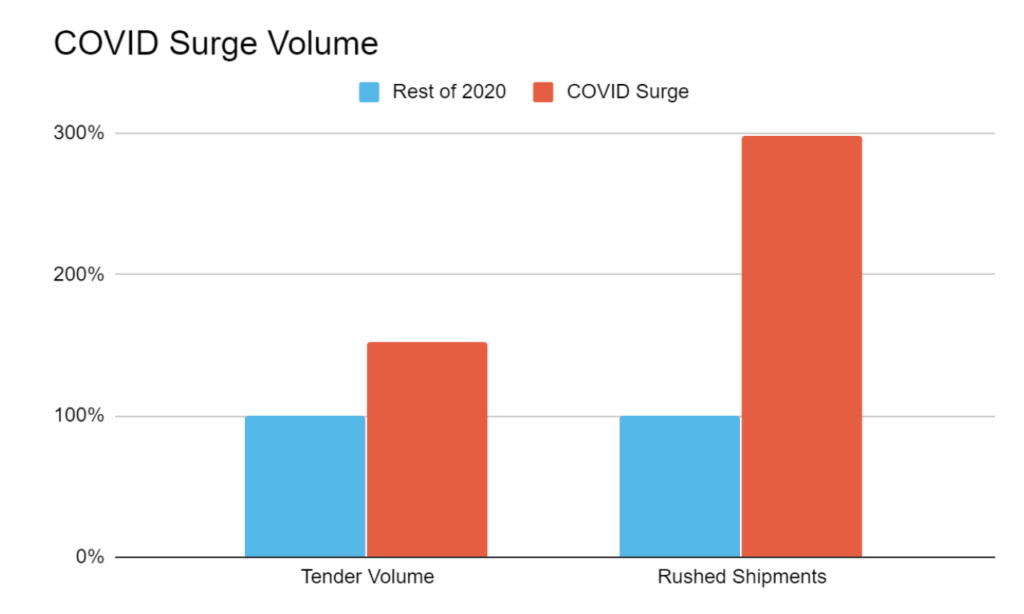Case study: When demand surges past supply chain forecasts
Industry Insights, Shippers • Published on December 2, 2020
Business planners put a great deal of effort into demand forecasting for their supply chains. Demand forecasting seeks to predict consumer demand to inform supply chain and business operations. The more accurate the demand forecast, the more efficiently a supply chain operates.
Even in typical business cycles, consumer demand is notoriously difficult to predict. 2020 has shown us that forecasting supply chain needs is near impossible. We all saw forecasts that went haywire this year in business planning as well as broader economic projections.
Despite the market volatility and uncertainty, customer expectations remain as high as ever. People expect quality service and on-time delivery, often on short notice. When forecasts are off, shippers’ ability to meet these expectations is jeopardized. In these situations, digital freight networks like Convoy can help.
Flexible capacity when demand forecasts are off
Convoy helps transportation teams meet the demands placed on their businesses by providing a source of flexible capacity. With instant access to hundreds of thousands of trucks connected to our platform, working with Convoy dramatically improves the chances there will be multiple trucks available to service your freight.
Carriers in our network respond to changing demand dynamics in real time, enabling us to offer flexible, on-demand capacity even when your volume surges unexpectedly. Whenever you tender to Convoy, we analyze our network to confirm that we have qualified carriers in the region that can make an on-time pickup at a competitive rate.
Case study: how Convoy covered demand surges beyond supply chain forecasts
Our digital freight network was put to the test in March 2020, one of the most volatile months in modern freight history. Supermarkets and grocers placed a high volume of orders with suppliers to keep their shelves stocked as consumer demand surged.
This posed a substantial challenge for one of our top food and beverage shippers. Not only did their customers need much more product, they needed it fast. Their tender volume increased by over 50% overall. Even more critically, their short-notice shipment volume (<24 hour lead time) tripled.

A shipment’s lead time is the period between when a tender is offered and when the load must be picked up. Lead time is critical for transportation providers because it’s their window to execute operational processes (load building, appointment scheduling, etc.) and get the load booked with a truck. Most tenders have ample lead time, but short-notice shipments are a race against the clock. Risk to performance increases when there are many short-notice shipments all happening at the same time, as we saw in March 2020.
Traditional freight brokerages that employ manual operations (phone calls, emails, back-and-forth negotiations) lack the efficiency to accommodate a surge of rush shipments. However, Convoy’s highly automated freight network excels at handling challenges like this.
Despite the magnitude and urgency of our shipper’s surge, we delivered on our promise of flexible, on-demand capacity. Our streamlined operational processes, automated freight matching and pricing, and our large and resilient carrier network, equipped us to help this customer and hit strong performance metrics. We accepted 20% more loads than our previous volume highs and maintained 98% tender acceptance, achieving 97% true OTD.
Supply chain forecasting with on-demand freight capacity
While 2020 showed us the limitations of predicting consumer demand, supply chain forecasting remains a critical component of business planning and operations. Working with a digital freight network like Convoy can provide peace of mind for logistics teams who need reliable and flexible carrier capacity at a moment’s notice.
You can read part two of this case study to learn how Convoy used supply chain analytics to help recoup TONU costs for our customer, saving them tens of thousands of dollars.



